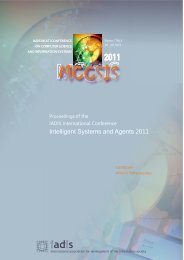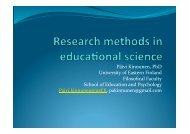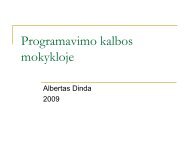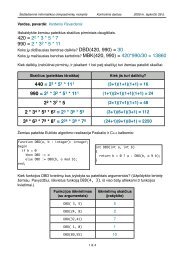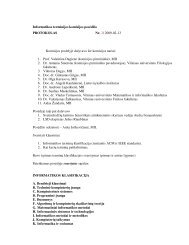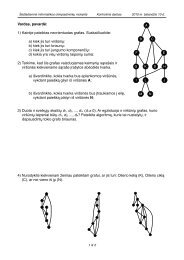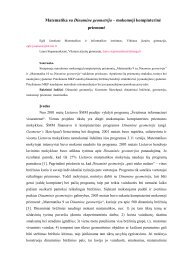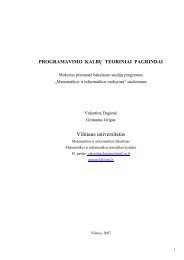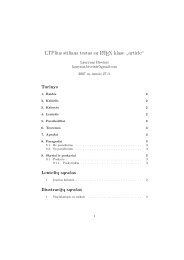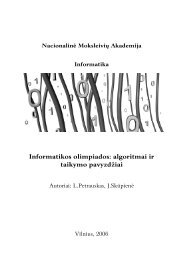innovation - Informatikos metodologijos skyrius - Matematikos ir ...
innovation - Informatikos metodologijos skyrius - Matematikos ir ...
innovation - Informatikos metodologijos skyrius - Matematikos ir ...
You also want an ePaper? Increase the reach of your titles
YUMPU automatically turns print PDFs into web optimized ePapers that Google loves.
educational success: f<strong>ir</strong>stly in learning and achieving – social computing<br />
tools can be used as didactic tools to enhance and improve learning<br />
processes and outcomes; secondly, in networking – supporting exchange of<br />
knowledge between teachers; th<strong>ir</strong>dly, through supporting greater diversity<br />
and inclusion in learning, and fourthly through opening up disciplinary and<br />
professional ‘silos’ to new forms of cross-boundary collaboration. The<br />
result, as illustrated in Figure 2, gives rise to new areas for <strong>innovation</strong> in<br />
learning, or ‘iLANDS’.<br />
<strong>innovation</strong><br />
Primary Education<br />
Secondary Education<br />
Higher Education<br />
Vocational<br />
Training<br />
Personal<br />
Development<br />
Learning<br />
&<br />
Achieving<br />
Networking<br />
Diversity<br />
Society<br />
Fig. 2. iLANDS<br />
Teacher<br />
Training<br />
Learning 2.0 in the Classroom<br />
On the basis of the results of reviews carried out in a number of studies<br />
on the use of Web 2.0 in learning and social inclusion (Cullen et al, 2009)<br />
combined with the current work being done in the ‘te@chus’ project<br />
(supported by the EC Comenius sub-programme) it is possible to identify<br />
some of the emergent themes, processes and activities that are developing<br />
in the context of ‘Learning 2.0 in the classroom’. The results show that,<br />
though a number of examples of classroom-based ‘Learning 2.0’ can be<br />
identified, Facebook has yet to colonise the school. Development and implementation<br />
is uneven and fragmented. Applications differ widely in scope,<br />
objectives and pedagogic and technical design. These applications can be<br />
grouped into broad categories. F<strong>ir</strong>stly, Web 2.0 tools are being used to<br />
build repositories of re-usable material that can be distributed for teachers<br />
to use in the<strong>ir</strong> lessons. An example is ‘Le Mill’ – which has almost 10,000<br />
reusable learning content resources, 4,500 descriptions of teaching and learning<br />
methods, and one thousand descriptions of teaching and learning tools.<br />
Teaching<br />
Practice<br />
7



